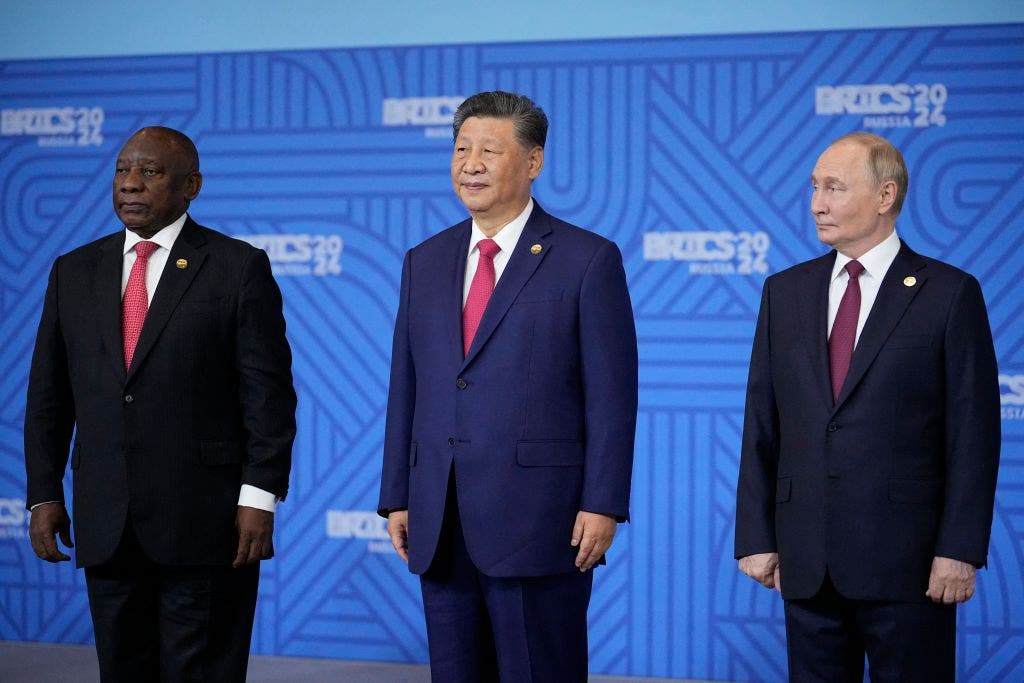Finance
Interested In Manulife Financial’s (TSE:MFC) Upcoming CA$0.40 Dividend? You Have Four Days Left

Regular readers will know that we love our dividends at Simply Wall St, which is why it’s exciting to see Manulife Financial Corporation (TSE:MFC) is about to trade ex-dividend in the next 4 days. The ex-dividend date is usually set to be one business day before the record date which is the cut-off date on which you must be present on the company’s books as a shareholder in order to receive the dividend. It is important to be aware of the ex-dividend date because any trade on the stock needs to have been settled on or before the record date. Accordingly, Manulife Financial investors that purchase the stock on or after the 20th of November will not receive the dividend, which will be paid on the 19th of December.
The company’s next dividend payment will be CA$0.40 per share. Last year, in total, the company distributed CA$1.60 to shareholders. Looking at the last 12 months of distributions, Manulife Financial has a trailing yield of approximately 3.5% on its current stock price of CA$46.23. Dividends are a major contributor to investment returns for long term holders, but only if the dividend continues to be paid. So we need to investigate whether Manulife Financial can afford its dividend, and if the dividend could grow.
View our latest analysis for Manulife Financial
If a company pays out more in dividends than it earned, then the dividend might become unsustainable – hardly an ideal situation. Manulife Financial paid out more than half (55%) of its earnings last year, which is a regular payout ratio for most companies.
When a company paid out less in dividends than it earned in profit, this generally suggests its dividend is affordable. The lower the % of its profit that it pays out, the greater the margin of safety for the dividend if the business enters a downturn.
Click here to see the company’s payout ratio, plus analyst estimates of its future dividends.
Companies with consistently growing earnings per share generally make the best dividend stocks, as they usually find it easier to grow dividends per share. Investors love dividends, so if earnings fall and the dividend is reduced, expect a stock to be sold off heavily at the same time. With that in mind, we’re encouraged by the steady growth at Manulife Financial, with earnings per share up 4.5% on average over the last five years.
Another key way to measure a company’s dividend prospects is by measuring its historical rate of dividend growth. In the past 10 years, Manulife Financial has increased its dividend at approximately 12% a year on average. It’s encouraging to see the company lifting dividends while earnings are growing, suggesting at least some corporate interest in rewarding shareholders.

Finance
Former Finance Manager of Historic Sotterley Charged with Embezzlement of $15,000

Angela Marie Hanson, 52, of California, Maryland, has been indicted on charges of embezzlement and theft following allegations of financial misconduct during her tenure as Finance Manager for Historic Sotterley, Inc. According to court documents, Hanson is accused of stealing nearly $15,000 over a five-month period from October 31, 2023, to April 15, 2024.
Hanson, who oversaw financial operations at the historic property, is scheduled for her initial court appearance in the Circuit Court for St. Mary’s County on January 13, 2025. She faces a felony charge of theft scheme involving $1,500 to $25,000, a misdemeanor embezzlement charge, 50 counts of theft between $100 and $1,500, and 17 counts of theft under $100.
Authorities allege that Hanson misappropriated funds using a debit card linked to Historic Sotterley’s “Museum Shop” account. Over 50 ATM withdrawals and several unauthorized purchases were reportedly made at local businesses, including gas stations and convenience stores.
Court filings claim Hanson also transferred funds between Historic Sotterley’s accounts to conceal her activities. Investigators allege that Hanson continued these actions even after her employment ended in February 2024.
The St. Mary’s County Sheriff’s Office led the investigation, which included reviewing banking records, witness testimony, and surveillance footage. Historic Sotterley’s Executive Director identified Hanson as the only individual with access to financial systems and administrative rights during the period in question.
Investigators state that surveillance footage shows Hanson conducting ATM withdrawals using the organization’s debit card. When questioned by law enforcement, Hanson acknowledged managing Historic Sotterley’s finances but denied any intent to defraud.
Finance
The Secret to Making Successful Financial New Year’s Resolutions – NerdWallet

The investing information provided on this page is for educational purposes only. NerdWallet, Inc. does not offer advisory or brokerage services, nor does it recommend or advise investors to buy or sell particular stocks, securities or other investments.
The start of a new year can bring a surge of motivation around setting new goals, including financial resolutions.
One way to help those goals become reality, financial experts say, is to make them as specific as possible. Then, track your progress, while allowing flexibility for unexpected challenges.
“It’s easier to track progress when we know where we are going,” says Sylvie Scowcroft, a certified financial planner and founder of The Financial Grove in Cambridge, Massachusetts.
That’s why she encourages her clients to set clearly defined goals, often related to paying off a specific debt, saving a certain amount per month or improving their credit score.
Here are more tips from financial experts about crafting 2025 financial goals:
Pick your top priorities
Trying to accomplish too much can feel overwhelming. Instead, pick your priorities, says Cathleen Tobin, CFP and owner of Moonbridge Financial Design in Rhinebeck, New York.
She suggests focusing on those big, often emotionally-driven goals to find motivation.
“It’s more compelling than just a number,” she says. For example, do you want to make sure you’re on track for retirement or save money for a house? “Start there.”
Be as specific as possible
Scowcroft says she sees clients get tripped up by selecting overly broad goals, such as “get better with money.” Instead, she encourages people to select specific action items, such as “sign up for a budgeting tool and set aside time each month to learn where my money is going.”
That level of specificity provides direction so you know what steps to take next, she adds. For example, if your top priority is to become debt-free, then your specific goal might be to pay off an extra $200 of your debt balance each month.
Tobin says labeling savings accounts so they correspond with goals can also help. An emergency fund could be named something like “Peace of mind in 2025,” so you remember why you’re saving every time you make a transfer.
“It’s more motivating than just ‘emergency fund,’” Tobin says.
Get more financial clarity with NerdWallet
Monitor your credit, track your spending and see all of your finances together in a single place.
Track your progress
Measuring your progress as the year unfolds is also a critical component of successful goal setting, Tobin says.
She compares it to weight loss. If you want to lose 20 pounds by June, then you need to lose about a pound a week for the first six months of the year. Similarly, she says it helps to break savings goals into microsteps that specify what you need to do each week.
Schedule a weekly or monthly check-in with yourself to make sure you are meeting those smaller goals along the way. You might want to review your debt payoff progress or check your credit score, for example.
“Being able to break it down into steps that can be done each week or twice a month really helps,” Tobin says.
Automate where you can
If your goal is to save more money, then setting up an automatic transfer each month can help turn that goal into reality, as long as you know you have the money in your checking account to spare.
“It reduces the mental load,” says Mike Hunsberger, CFP and owner of Next Mission Financial Planning in St. Charles, Missouri, where he primarily supports veterans and current members of the military.
He recommends starting small to ease into the change.
“I wouldn’t jump to double what you’re currently saving,” he says. For example, when it comes to saving in a retirement account, if you’re starting with a 3% contribution, you might want to bump it up to 4%, then slowly increase it from there.
“My number one piece of advice is to start small, but make sure you scale over time,” Hunsberger adds. “Because it’s gradual, you probably won’t notice it impacting your lifestyle.”
Adjust as needed
“Stay flexible,” Scowcroft says. “Part of it is just being kind to yourself and not being too rigid.”
When unexpected challenges come up, such as a big unplanned expense, you might have to pause making progress on your goal and reset.
You might even need to change your goal. Scowcroft says that doesn’t mean you “failed,” just that life changed your plans. Dwelling on any negativity won’t help your forward progress.
Team up with a friend
Sharing your goals with a friend can also make it easier to reach them, Scowcroft says.
“It really helps to have an accountability buddy,” she says.
She suggests putting a regular “money date” with your friend on the calendar so you can ask each other how you’re doing, brainstorm any challenges or even budget together side-by-side.
“It’s a fun excuse to meet up with a friend.”
Get more financial clarity with NerdWallet
Monitor your credit, track your spending and see all of your finances together in a single place.
Finance
I’m not financially literate. Here’s how I could be. – The Boston Globe

If you asked me what the process for setting up a Roth IRA looked like, I doubt I could offer you a thorough response. The same goes for mortgages and loans and interest. When I had to fill out my first W-9 form, I was admittedly more than a bit confused.
In short, financial literacy isn’t my forte. And that’s because, like many Massachusetts public school students, I’ve never had to take any sort of personal finance class.
Indeed, throughout the debates over eliminating MCAS as a graduation requirement for high schoolers, we heard quite a bit about the state’s educational gold standard. So is it not the least bit shameful, or at least embarrassing, that our state does not require high school students to take a financial literacy class when a majority of states do?
Absolutely. And it needs to change.
Twenty-six states, including Rhode Island, New Hampshire, and Connecticut, have passed legislation making a personal finance course mandatory for high school students. Meanwhile, Massachusetts received an “F” from the Champlain College Center for Financial Literacy, which released a report card in 2023 evaluating how each “state delivers personal finance education in its public high schools.” In addition, a 2023 report card(link?) from the American Public Education Foundation gave the state a “C” for its financial literacy requirements — a score worse than or equal to all but six states.
Meanwhile, across the state, credit card and student loan debt have spiked to eye-popping levels. As of the second quarter of this year, the average Massachusetts resident had a credit card balance of $8,556 and $33,710.38 in student loan debt. The latter is particularly troubling for young people like myself. For the next four years, countless high school seniors throughout the Commonwealth will be attending college, paying tens of thousands of dollars on top of day-to-day expenses.
The need for personal finance courses in Massachusetts is tremendous — a need that, as per a 2021 report from the state’s Office of Economic Empowerment, is recognized almost universally among teachers and, importantly, students.
Yet, as a result of being taught next to nothing about personal finances, many of us are left ill-prepared for these new circumstances. Our understanding of credit cards is limited to, as State Treasurer Deb Goldberg so eloquently articulated to GBH, “The parent puts a plastic card into the wallet and boom: out comes money.” And so the cycle of taking out loans, accumulating massive debt, and working for years before being able to pay it off persists.
Why perpetuate the cycle when it is so clear that these classes work? According to a 2021 Ramsey Solutions survey, among the teenagers who have completed a personal finance class, nearly 80 percent said that they’ve created a monthly budget for themselves, 94 percent felt confident about saving money, and 87 percent understood how to pay income taxes. And, as noted in the OEE’s report, personal finance courses are tools that “increase social mobility for low-income or immigrant students.” Requiring such classes really couldn’t make much more sense.
At my own high school, Brookline High School, financial literacy is offered in the form of a popular elective, “The World of Money: Practical Studies in Finance and Investment,” which “integrates the basic principles of economics, money management, investing, and technology,” according to the course catalog. Every spring, as course selection rolls around, hundreds of students eye this semester-long course, but with only so many spots, most cannot take it — and, consequently, miss out on an opportunity to learn about financial literacy.
Recognizing the imminent need to educate ourselves on matters of taxes, loans, investments, and more, several members of Brookline High School’s Student Council, including myself, have proposed amendments to our student handbook that would incorporate a financial literacy component in our graduation requirements and incorporate personal finance lessons into our weekly advisory classes. Our work would ensure that such important life skills are accessible to all students, not merely for those lucky enough to find a place in the class.
But while such efforts are certainly a step in the right direction on this issue, they are not enough. Financial literacy should not be a privilege for schools with a proactive student body; it is a fundamental aspect of our lives, and our state’s education system must begin reflecting that. The state must require personal finance courses for graduation — it’s the smartest investment we can make.
Ravin Bhatia is a senior at Brookline High School.
-
/cdn.vox-cdn.com/uploads/chorus_asset/file/24924653/236780_Google_AntiTrust_Trial_Custom_Art_CVirginia__0003_1.png)
/cdn.vox-cdn.com/uploads/chorus_asset/file/24924653/236780_Google_AntiTrust_Trial_Custom_Art_CVirginia__0003_1.png) Technology5 days ago
Technology5 days agoGoogle’s counteroffer to the government trying to break it up is unbundling Android apps
-

 News6 days ago
News6 days agoNovo Nordisk shares tumble as weight-loss drug trial data disappoints
-

 Politics6 days ago
Politics6 days agoIllegal immigrant sexually abused child in the U.S. after being removed from the country five times
-

 Entertainment7 days ago
Entertainment7 days ago'It's a little holiday gift': Inside the Weeknd's free Santa Monica show for his biggest fans
-

 Lifestyle6 days ago
Lifestyle6 days agoThink you can't dance? Get up and try these tips in our comic. We dare you!
-

 Technology1 week ago
Technology1 week agoFox News AI Newsletter: OpenAI responds to Elon Musk's lawsuit
-
/cdn.vox-cdn.com/uploads/chorus_asset/file/25672934/Metaphor_Key_Art_Horizontal.png)
/cdn.vox-cdn.com/uploads/chorus_asset/file/25672934/Metaphor_Key_Art_Horizontal.png) Technology2 days ago
Technology2 days agoThere’s a reason Metaphor: ReFantanzio’s battle music sounds as cool as it does
-

 News3 days ago
News3 days agoFrance’s new premier selects Eric Lombard as finance minister




/cdn.vox-cdn.com/uploads/chorus_asset/file/25742882/DSC_1384_Enhanced_NR.jpg)










